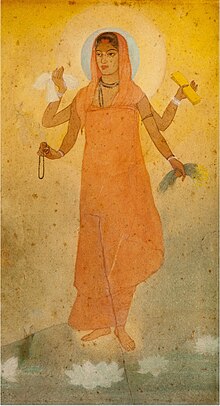Bengal School of Art
This article needs additional citations for verification. (June 2020) |

The Bengal School of Art, commonly referred as Bengal School,
History
| Part of a series on the |
| Culture of Bengal |
|---|
 |
| History |
| Cuisine |
The Bengal school arose as an
The Bengal school's influence in India declined with the spread of
Bimal Sil was a contemporary of Abanindernath Tagore. He painted in water colours. His paintings are found in private collections only.
Legacy
The Bengal School of Art, which emerged in the first half of the twentieth century, has produced a significant legacy in the world of Indian art.[7] Its deep impact on the cultural landscape of India and its role in shaping the trajectory of modern Indian art cannot be overstated. Led by eminent artists such as Abanindranath Tagore, Nandalal Bose, and Rabindranath Tagore, the Bengal School emerged as a powerful movement that sought to revive traditional Indian artistic practices and forge a unique national identity. However, it is important to note that "while a special kind of nationalist sentiment is present in the paintings of Abanindranath and in the ideas of Rabindranath, there was always an aversion to direct political confrontation at the core of those sentiments".[7] Artists of this style include Amit Sarkar, Ajoy Ghosh, Sankarlal Aich, Amal Chaklader, Narendra Chandra De Sarkar, Sukti Subhra Pradhan, and Ratan Acharya. Some of the best known artists of present-day Bengal are Jogen Chowdhury, Mrinal Kanti Das, Gopal Sanyal, Ganesh Pyne, Manishi Dey, Shanu Lahiri, Ganesh Haloi[8] Jahar Dasgupta, Samir Aich, Bikash Bhattacharjee, Manindra Bhushan Gupta, Sudip Roy, Ramananda Bandopadhyay and Devajyoti Ray.
R. Siva Kumar's disagreement
His ideas on this issue are formulated in the catalogue essay of the exhibition Santiniketan: The Making of a Contextual Modernism.
See also
- Contextual Modernism
- Modern Indian painting
- Progressive Artists' Group
- Tanjore painting
- Rajput painting
- Madhubani painting
References
- ^ a b c "Showcase - Bengal School". National Gallery of Modern Art.
- ISBN 978-0-521-44354-8. Retrieved 8 March 2012.
- ISBN 978-1-85669-377-6. Retrieved 8 March 2012.
- ISBN 0-19-284221-8.
Ernest Binfield Havell education.
- ^ Cotter, Holland (August 19, 2008). "Art Review: Indian Modernism via an Eclectic and Elusive Artist". New York Times.
- ^ Ghose, Archana Khare (12 February 2012). "For many art lovers, it's back to the old school". The Times of India. New Delhi. Archived from the original on 8 May 2013. Retrieved 8 March 2012.
- ^ a b Cohen, Jasmin (2012). "Nationalism and Painting in Colonial Bengal". Unpublished Paper – via SIT Digital Collections.
- ^ "Shanu Lahiri dead". The Telegraph (Calcutta). Archived from the original on February 7, 2013. Retrieved March 15, 2013.
- ^ "Humanities underground » All the Shared Experiences of the Lived World II".
Further reading
- Bagchi, Jasodhara. (1990). Representing Nationalism: Ideology of Motherhood in Colonial Bengal. Economic and Political Weekly, 25(42/43), WS65–WS71. JSTOR 4396894
- Eaton, Natasha. (2013). “Swadeshi” Color: Artistic Production and Indian Nationalism, ca. 1905–ca. 1947. The Art Bulletin, 95(4), 623–641. JSTOR 43188857
- Havell, E. B. (1920). A Handbook of Indian Art. John Murray, London.
- Jamal, Osman (1997). E B Havell: The art and politics of Indianness. Third Text, 11(39), 3–19.
- ISBN 1856693775.
- Kossak, Steven (1997). Indian court painting, 16th-19th century. New York: The Metropolitan Museum of Art. ISBN 0870997831. (see index: p.148-152)
- Sircar, Sanjay. (1998). Shashthi’s Land: Folk Nursery Rhyme in Abanindranath Tagore’s “The Condensed-Milk Doll.” Asian Folklore Studies, 57(1), 25–49. https://doi.org/10.2307/1178995
- Thakurta, Tapati Guha. (1991). Women as “Calendar Art” Icons: Emergence of Pictorial Stereotype in Colonial India. Economic and Political Weekly, 26(43), WS91–WS99. JSTOR 4398221
- Wong, A. Y. (2009). "6. Landscapes Of Nandalal Bose (1882–1966): Japanism, Nationalism And Populism In Modern India". In Okakura Tenshin and Pan-Asianism. Leiden, The Netherlands: Brill. doi: https://doi.org/10.1163/ej.9781905246618.i-176.19
